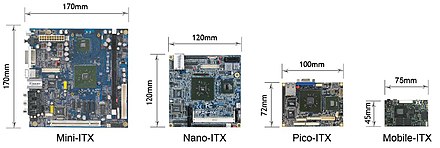

Mini-ITX is a 170 mm × 170 mm (6.7 in × 6.7 in) motherboard form factor developed by VIA Technologies in 2001.[1] Mini-ITX motherboards have been traditionally used in small-configured computer systems. Originally, Mini-ITX was a niche standard designed for fanless cooling with a low power consumption architecture, which made them useful for home theater PC systems, where fan noise can detract from the cinema experience.
The four mounting holes in a Mini-ITX board line up with four of the holes in ATX-specification motherboards, and the locations of the backplate and expansion slot are the same[2] (though one of the holes used was optional in earlier versions of the ATX spec). Mini-ITX boards can therefore often be used in cases designed for ATX, micro-ATX and other ATX variants if desired.
Mini-ITX motherboards have only one expansion slot. Earlier Mini-ITX motherboards had a standard 33 MHz 5V 32-bit PCI slot, whereas newer motherboards use a PCI Express slot. Many older case designs use riser cards and some even have two-slot riser cards, although the two-slot riser cards are not compatible with all boards. Some boards based around non-x86 processors have a 3.3V PCI slot, and the Mini-ITX 2.0[3] (2008) boards have a PCI-Express ×16 slot; these boards are not compatible with the standard PCI riser cards supplied with older ITX (Information Technology eXtended) cases.
The HiFive Unmatched RISC-V computer uses a Mini-ITX form factor.[4][5][6]
- ^ Mini ITX (PDF) (whitepaper), TW: VIA, archived from the original (PDF) on 2011-06-13.
- ^ Mini-ITX Interface Specification, version 1.1/1.2 (PDF), Intel, archived from the original (PDF) on 2018-02-05
- ^ "Mini-ITX 2.0 Standard" (announcement). TW: VIA. Archived from the original on 2008-06-18.
- ^ "SiFive HiFive Unmatched Hands-On, Initial RISC-V Performance Benchmarks".
- ^ https://hothardware.com/reviews/hifive-unmatched-a-risc-v-proposition [bare URL]
- ^ "HiFive Unmatched - SiFive Boards".